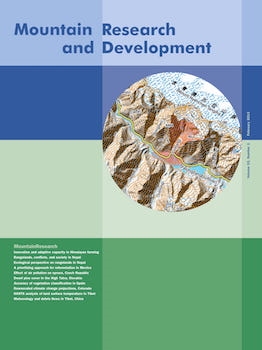Upland Agriculture and the Environment by Lois Mansfield. Bowness-on-Windermere, United Kingdom: Badger Press, 2011. xv + 360 pp. £ 20.00. ISBN 978-0-9570747-0-5.
This comprehensive textbook on upland management in the British Isles combines a critical understanding of upland agriculture and related environmental issues with an assessment of the political decisions that have affected these regions over the past 50 years. Lois Mansfield, an agricultural geographer, has delivered this well, in a detailed and well-illustrated textbook suitable for both academic and professional audiences.
The book has 9 chapters, which cover environmental, social, economic, and political issues and practices related largely to the upland regions of England and Wales. Chapter 1 provides the reader with an in-depth understanding of the upland farming system, which explains the distinct character of hill and upland farms, and which allows farmers to exploit variations in topography and move stock around the land to make the best possible use of resources. Particular attention is given to the production of sheep and cattle in upland environments, including breeding practices and fodder provision. Chapter 2 tackles a difficult question: “Where are the uplands?” Across Europe, uplands have been defined in many ways, ranging from simple parameters, for example, altitude, to more complex administrative and cultural classifications. Considerable attention is given to the pitfalls of using the European Commission's Less Favoured Areas classification for delimiting these regions, in addition to the implications for agricultural policy of a lack of clarity.
Chapter 3 unpacks the historical development of upland agriculture and explains how upland landscapes are a product of the ways that successive cultures have used the land in the British Isles over many thousands of years. The chapter includes accounts of uplands as places for natural hunting grounds, the introduction of cultivation by Neolithic people, the development of field systems in the Bronze Age, gradual intensification and large-scale sheep and cattle production in the 11th–15th centuries, and the development of landlord–tenant relationships and large-scale land ownership reforms. In culminating with the agricultural depression of the early 20th century, it is explained how upland areas became “marginalised economically, politically and physically [and how] upland farmers found themselves to be unable to climb out of the poverty trap” (p 95). Chapter 4 explains how this marginalization and the “hill farming problem” are compounded by the physical constraints within which farmers must operate in upland regions. These include climate (and associated growing seasons), geology, and soil variations.
Chapters 5, 6, and 7 provide the reader with more detail on the contemporary upland environment (particularly as a High Nature Value landscape [another European designation]), the economics of upland agriculture, and the social dimension, respectively. In Chapter 5, it becomes apparent that the uplands contain much of the UK's seminatural and near-natural vegetation. However, activities such as afforestation, peat extraction, water collection, recreation, and agriculture have all had impacts on habitat condition in the uplands: Mansfield explores these impacts in some detail. Chapters 6 and 7 provide a timely socioeconomic context to the predominantly environmental focus of the book thus far and explore how upland farms produce some of the lowest gross margins of any farm type in the UK, which has had implications for social capital in these areas. This has had implications for the development and implementation of agricultural subsidies for British and other European uplands as well as the emphasis on diversification as a way of maintaining farm households.
The final chapters give the political context and provide a thorough overview of agricultural legislation and subsidies at the scale of the European Union and a discussion of “a future for upland agriculture.” In recognizing the shift toward rural development and environmental management as the central philosophies of upland agriculture, the book closes with a discussion of the implications of considering uplands as locations that deliver “ecosystem services,” as an attempt to pull them out of the conceptual margins of the agricultural debate. This places uplands more at the forefront of societal concern and frames them as vitally important regions that provide society with a range of services (both tangible and intangible), such as food, fuel, flood regulation, and cultural heritage.
This book provides a timely, interdisciplinary understanding of issues related to agriculture in upland areas and is a nice accompaniment to Bonn et al (2009) (reviewed in Mountain Research and Development 30[1]). Agricultural students will also find this an excellent resource for their studies. The focus on England and Wales means that those who hope to learn more about upland management in Scotland may be disappointed, but this does not detract from the high-quality detailed nature of this textbook. The implications of an ecosystem services approach for upland agriculture could have been considered in more detail, but this is still an emerging debate (eg see van der Wal et al 2011). It is pleasing that the book includes socioeconomic issues in uplands, particularly when debates about the uplands tend to focus on biodiversity and environment concerns, although the principal focus of the book is on agricultural aspects. Mansfield acknowledges the importance of local knowledge systems in upland agriculture, and this is teased out further with recognition of the need for policy-makers to engage fully with the farming community if farmers are to be in a position to “take better decisions about what is best economically, socially and environmentally for their individual businesses and to help them work collaboratively in order to achieve effective catchment-scale management” (p 322). With the move toward more holistic considerations of upland regions, this is a sensible conclusion, which emphasizes the importance of working with farmers (and other upland stakeholders) to understand, prioritize, and deliver multiple benefits in these areas.





